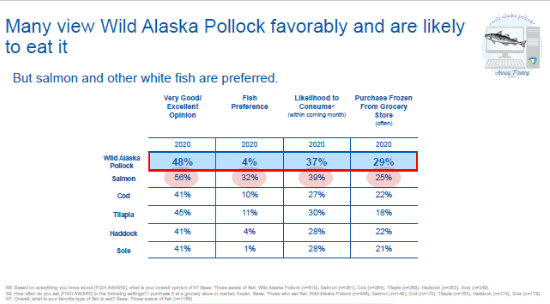October 12, 2020
Wild Alaska Pollock Consumer Awareness, Familiarity Continues to Grow Say Experts

Year-over-year findings for U.S. consumers / Data from Ketchum Analytics
Year-over-year research shows that at least ten million more consumers know about Wild Alaska Pollock and its core attributes in the U.S. today than did one year ago, the Association of Genuine Alaska Pollock Producers (GAPP) announced today. Familiarity with Wild Alaska Pollock among U.S. consumers rose three percent this year from 52% in 2019 to 55% in 2020, data and insights experts noted today during the Wild Alaska Pollock industry Annual Meeting.
“Great gains have been made but there’s lots of opportunities ahead and we need to turn up the volume,” said Mary Elizabeth Germaine of Ketchum Analytics. “Wild Alaska Pollock fits perfectly into what consumers are looking for including a healthier alternative to meat.”
GAPP had set out an ambitious goal of achieving an increase in consumer familiarity with Wild Alaska Pollock year-over-year, which was achieved by three percent, according to the research conducted in August.
Germaine further explained that generating greater awareness and familiarity with Wild Alaska Pollock among the general population remains a communications imperative. Increasing visibility of Wild Alaska Pollock can aid opinion and preference compared to other species. Fish-eating consumers’ experimentation and purchase of fish has soared amid COVID, making now a prime opportunity for Wild Alaska Pollock as there is high demand for healthy, easy-to-prepare and sustainable fish.
“We can see Google searches for Wild Alaska Pollock steadily growing over the past three years. We’re also seeing more searches for sustainability connected to your fish,” added Germaine. “Sustainability is more important to the fish-eater audience than it is to a general audience overall.”
Going forward, Wild Alaska Pollock must leverage the “white fish halo” as an approach to lift familiarity, and tout Wild Alaska Pollock’s sustainability differentiator in its messaging to consumers in the U.S. market.
“We need to increase people’s association of Wild Alaska Pollock and the white fish category,” said Germaine. “Building from there and talking about the sustainability differentiator will help convert even more and drive more demand.”
Consumer’s ‘table stakes’ when purchasing seafood are taste, cost, health and ease of preparation. Wild Alaska Pollock is delivering on ease, currently, but needs to elevate when it comes to taste, cost and health.
“Once you’re within the consideration set, the things that stand out as differentiators are all about versatility, provenance and sustainability,” explained Germaine. “Versatility is what helps people select fish over another protein and it’s the number one factor that causes people to choose between different fish species. Wild Alaska Pollock needs to drive an increase in recognition of Wild Alaska Pollock as a versatile ingredient, as center-of-the-plate, as a protein option.”
The second-ever Wild Alaska Pollock Annual Meeting was held today, virtually. Sponsors for the event include: American Seafoods, Alaska Seafood Marketing Institute, Clark Nuber, Garrigan Lyman Group, Glacier Fish Company, Global Seas, Golden Alaska Seafoods, Starbound, Sysco Seattle, Trans-Ocean Products, OneforNeptune and UniSea.

